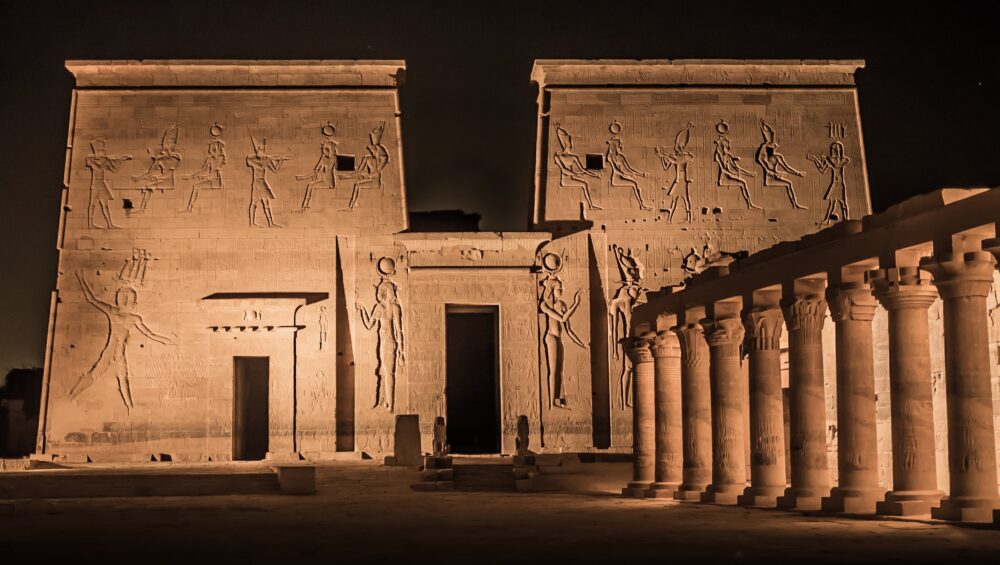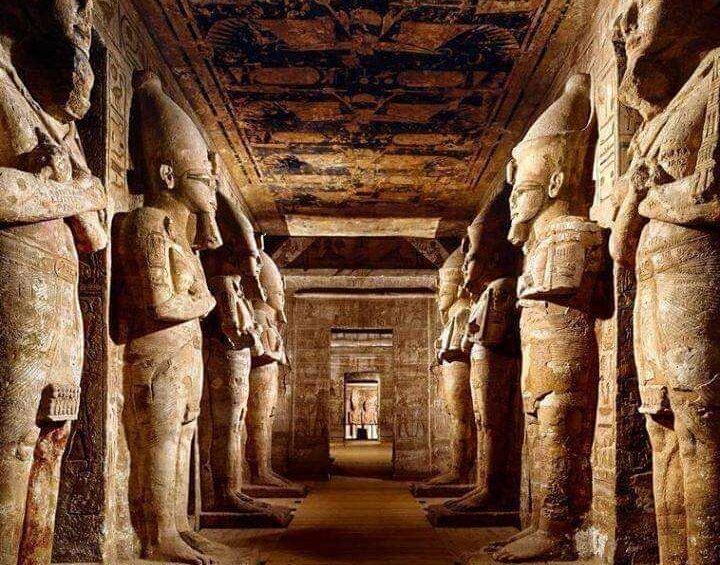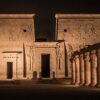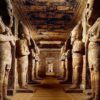Philae Temple . ISIS & OSIRIS
Philae Temple
ISIS & OSIRIS
A Complete Guide

-
Why is it Called the “Philae Temple”?
The name “Philae” (Greek: Φιλαί, Arabic: فيلا) comes from the ancient Egyptian term “P-aaleq” (𓊪𓄿𓃭𓅱𓊖), meaning “the end” or “remote place.” This refers to its location near the southern frontier of Egypt. The Greeks later adapted it to “Philae.”
Some scholars also link the name to the Coptic word “Pilak”, meaning “corner,” as the temple was situated on an island at the edge of Egypt’s dominion.
-
Location of the Philae Temple
Originally, the temple stood on Philae Island in the Nile near Aswan. However, due to the construction of the Aswan Low Dam (1902) and High Dam (1960s), the temple was submerged underwater for most of the year.
To save it, UNESCO led a massive relocation project (1972–1980), moving the temple block-by-block to Agilkia Island, about 500 meters away. Today, visitors access it by boat from Aswan.

-
When Was the Philae Temple Built?
- Earliest construction: Begun by Pharaoh Nectanebo I (380–362 BCE)of the 30th Dynasty (Late Period).
- Major expansions: Carried out by the Ptolemies (Greek rulers, 332–30 BCE)and Roman Emperors (Augustus & Tiberius, 1st century CE).
- Latest additions: Some inscriptions date to Emperor Diocletian (3rd–4th century CE).
Unlike most Egyptian temples built by pharaohs, Philae was largely developed under foreign rulers who revered Egyptian gods.
-
What Does the Temple Contain Inside?
The Philae Temple Complex includes several structures:
The Temple of Isis (Main Temple)
- First Pylon: Massive gateway with reliefs of Ptolemy XII smiting enemies.
- Birth House (Mammisi): Depicts the divine birth of Horus, son of Isis and Osiris.
- Inner Sanctuary: Once held the sacred golden statue of Isis(now lost).
- Nilometer: Used to measure the Nile’s water levels for flood predictions.
The Kiosk of Trajan (Pharaoh’s Bed)
- A beautiful, unfinished Roman pavilion with 14 columns, built by Emperor Trajan.
Temple of Hathor
- Features musical reliefsof Bes (dwarf god of dance) and musicians.
Temple of Horus (Harendotes)
- Dedicated to Isis’ son, Horus, in his form as “Horus the Avenger.”
Christian Influence
- After Christianity spread, parts were converted into a church (6th century CE). Crosses and Coptic graffiti can still be seen.
-
Why Was the Philae Temple Destroyed?
- Natural Causes: Flooding from the Aswan Low Dam (1902)submerged Philae for months each year, eroding its reliefs.
- Religious Conflict: Early Christians defaced some pagan carvings.
- Salvage Operation: The High Dam (1960s)threatened to drown it permanently, prompting UNESCO to relocate it.

-
Why Do Tourists Visit Philae Temple?
- Last Active Pagan Temple: One of the final places where ancient Egyptian religion was practiced(until 537 CE).
- Sound & Light Show: A famous nighttime spectacle narrating Isis’ legends.
- Architectural Beauty: Blends Egyptian, Greek, and Roman styles.
- Mythological Significance: Linked to Isis, Osiris, and Horus—central to Egyptian mythology.
-
Philae Temple Opening Hours & Tickets
- Opening Hours: 7:00 AM – 4:00 PM (Winter), 7:00 AM – 5:00 PM (Summer).
- Sound & Light Show: Evening sessions (multiple languages).
- Ticket Cost: ~500 EGP(foreign tourists), discounts for students.
10 Lesser-Known Facts About Philae Temple
- The last hieroglyphic inscription(394 CE) and demotic text (452 CE) in history were found here.
- Napoleon’s troopsdrew the first modern sketches of Philae in 1799.
- Isis worshipcontinued here 200 years after Rome became Christian.
- The temple was a pilgrimage sitefor Nubians, Greeks, and Romans.
- Cleopatra VIImay have visited Philae.
- The sacred Isis statuewas smuggled to Rome before Christianity banned her cult.
- Agilkia Island, where it now stands, was reshaped to mimic original Philae.
- The temple’s axisaligns with the Nile’s flow, unlike most Egyptian temples.
- A hidden chamberbeneath the sanctuary may have held Osiris’ relics.
Philae was considered a burial place of Osiris (Abaton Island nearby was believed to hold his body).
The Goddess Isis: Myths & Facts in Egyptology

Who Is Isis?
- Goddess of Magic, Motherhood, and Healing
- Wife of Osiris, mother of Horus
- Symbols: Throne headdress, ankh, tyet (knot of Isis)
Key Myths
- Resurrection of Osiris: Isis reassembled Osiris after his murder by Set, creating the first mummy.
- Protector of Horus: Hid Horus in the Delta marshes to save him from Set.
- The Secret Name of Ra: Tricked Ra into revealing his true name to gain divine power.
Cult & Worship
- Spread to Rome: Temples built as far as London (Londinium).
- Linked to Virgin Mary: Early Christians merged her imagery with Mary.
- Last Pagan Stronghold: Philae was her most sacred site.
Isis: The Divine Mother of Egypt.
Her Relationships with Osiris, Horus, and Anubis
Isis (Egyptian: Aset or Auset, 𓊨𓏏𓆇𓁐) was one of the most important goddesses in ancient Egyptian religion. She was worshipped as the ideal mother, wife, and magician, embodying love, healing, and resurrection.
Her relationships with Osiris, Horus, and Anubis form the core of one of Egypt’s most enduring myths—the Osiris Cycle—which explains life, death, and kingship.
-
Isis and Osiris: The Sacred Marriage
Roles:
- Isis: Goddess of magic, fertility, and protection.
- Osiris: God of the afterlife, resurrection, and agriculture.
The Myth:
- Osiris was the first divine king of Egypt, ruling wisely with Isis as his queen.
- His jealous brother Set (Seth)murdered him by tricking him into a coffin, which was thrown into the Nile.
- Isis searched tirelesslyfor Osiris’ body, finding it in Byblos (Lebanon).
- Using her magical powers, she briefly revived Osiris and conceived their son, Horus.
- After Osiris’ second death, she helped Anubismummify him, making Osiris the first mummy and ruler of the Duat (underworld).
Symbolism:
- Their love symbolized eternal devotion and resurrection.
- Osiris’ resurrection was linked to the Nile’s flooding and crop cycles.
-
Isis and Horus: The Protective Mother
Roles:
- Horus: Sky god, divine avenger, and rightful heir to Osiris’ throne.
The Myth:
- After Osiris’ death, Isis hid Horus in the Delta marshes(Chemmis) to protect him from Set.
- She used magic spellsto heal him when he was stung by scorpions (a story told in the Metternich Stela).
- When Horus grew up, she supported his battle against Setto reclaim his father’s throne.
Symbolism:
- Isis’ protection of Horus made her the archetype of motherhood(similar to the Virgin Mary in Christianity).
- The Horus-Set conflictrepresented the struggle between order (Ma’at) and chaos (Isfet).
-
Isis and Anubis: The Secret Son?
Roles:
- Anubis: God of mummification and guardian of the dead.
The Myth (Lesser-Known Version):
- In some late traditions, Anubis was secretly the son of Osiris and Nephthys(Isis’ sister).
- Nephthys, disguised as Isis, seduced Osiris, and when Set discovered this, she abandoned the baby.
- Isis found and raised Anubis, making him her adopted son and ally in mummifying Osiris.
Symbolism:
- Anubis’ role in Osiris’ resurrection reinforced Isis’ power over death and rebirth.
- Their bond showed her compassion, as she accepted Anubis despite his origins.
Conclusion: The Divine Family’s Legacy
- Isis & Osiris→ Represent love, death, and resurrection.
- Isis & Horus→ Symbolize motherly protection and royal succession.
- Isis & Anubis→ Highlight her mercy and mastery over funerary rites.
This myth cycle was so influential that Isis worship spread to Greece and Rome, where she was called “Isis Myrionymos” (Goddess of a Thousand Names).




